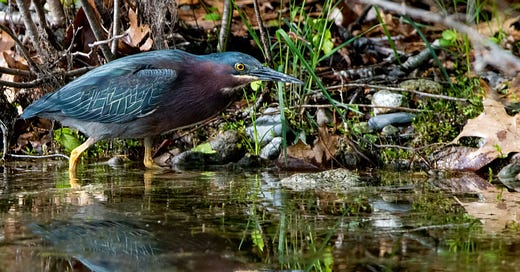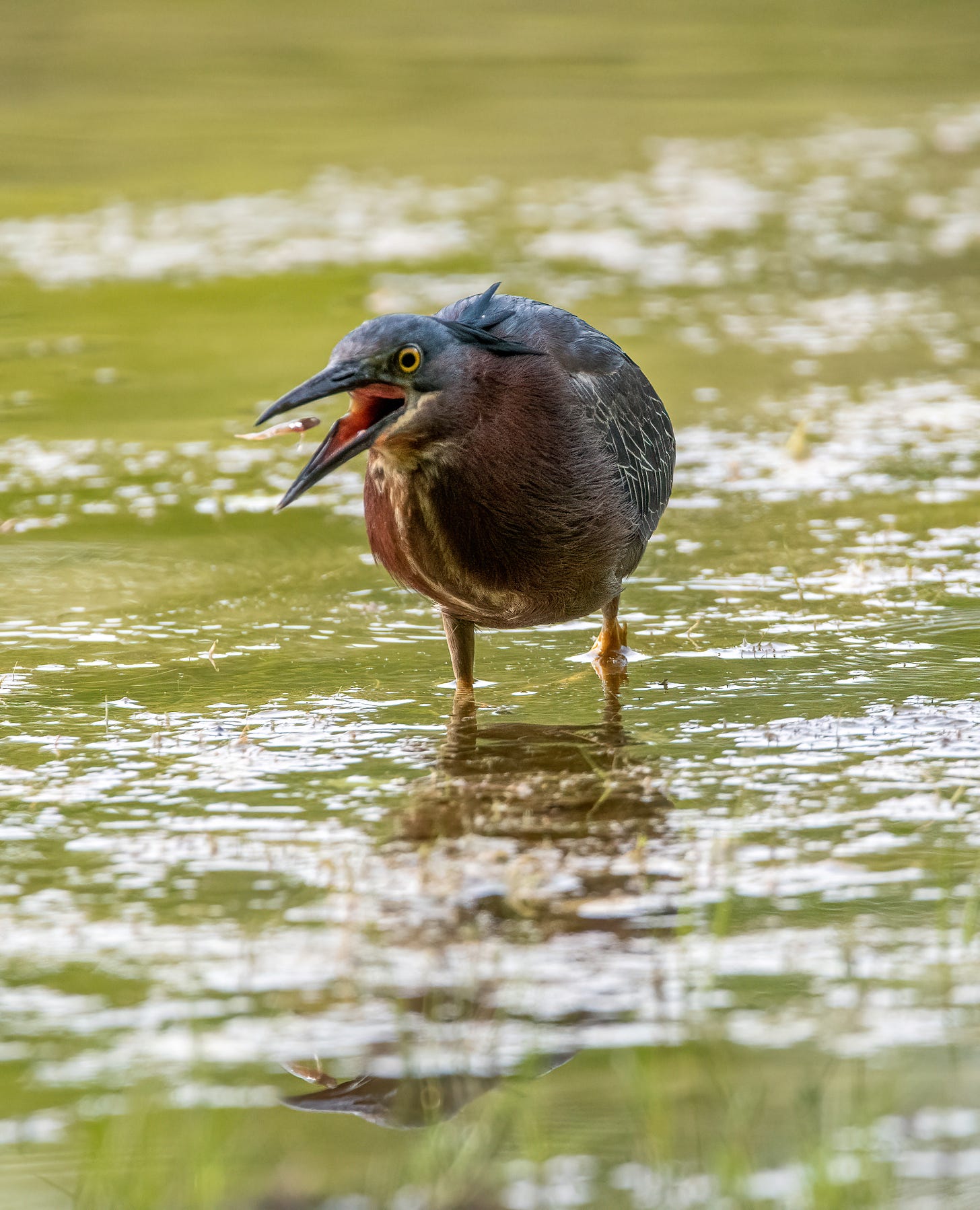Most days, from just before seven to a little before ten in the morning, I sit by a pond. I am luckily compensated to do this. Sometimes life is not so bad.
With this regularity comes the privilege of getting to know the locals. The catbirds are sociable and raucous. They mew. They also do just about everything else. You can listen to as many recorded catbird calls as you want, but sit and watch one for a reasonable stretch of time and you’ll see it make a sound you wouldn’t readily attribute to a catbird.
The wrens are loud, too. Predictably. The towhees bathe furtively in the shallows, sheltered by the underbrush along the bank, usually a couple of yards to my immediate right. Various sorts of panfish will nibble at your toes if you dangle them off of the dock. Largemouth bass, swimmers tell me, grow large and territorial. They too prey upon toes. As the summer progresses, summersweet blooms. It is aptly named. Beech trees thrive in the shade. The pallid brown leaves they hung onto all winter are again green.
But here at the pond, at least to me, the birds reign. There are few things so thrilling as the metallic ring of a kingfisher call screaming across the pond’s still water in the morning hours. As with wrens, it is remarkable that such a racket can come from such a small bird.
Another relatively small bird I get to observe at the pond is the green heron. They’re small for a heron, compared to the great blue, maxing out in height at around 18 inches—and they look a great deal shorter due to their posture. They’re odd birds. Like painted pterodactyls meant to fit in a backpack. When I showed a photograph of one to my friend, he replied: “What is that ugly creature.” I thought his reaction was unfair and uncalled for.
I don’t find the green heron ugly, not in the slightest, but it surely doesn’t do itself any favors. Let me recall some observations I made, watching a bird I saw one recent morning.
It was ungraceful in flight. The green heron announced itself at the pond, a little after seven, arriving from over the treetops—making its strange throaty sound as it eventually swooped into a landing in what I would best describe as a flappy aerial stumble. When on the ground, it hunched along the shore. When not standing perfectly still, it moved at two speeds which blended into one: a crawl and a lurch. Each evened out the other.
Stalking the shallows, the green heron clucked along, thrusting its neck forward jerkily, while the bird’s legs crept along slow and smooth, gangly feet raking the water. I struggled to think of an apt comparison: a mischievous teenager sneaking back into the house past curfew? A leery old man in need of a cane? Neither quite right.
When the heron is still, it is still. So still it is easy to miss. Look away for a second and you might not be able to find it again. Its purple chest and blue-green back wouldn’t seem a likely recipe for camouflage, but the colors work quite well along the edge of the pond.
The heron’s stillness is loaded, anticipatory. With remarkably smooth slowness, it raises and extends its neck, turns its head. Its movement seems an illusion. Less like the heron itself is moving, but more as if everything is moving around the stillness of the heron.
Then, the loaded moment reaches its climax: the heron strikes downward into the water with its long spear-like beak. The speed is startling, particularly after watching the bird move so slowly for so long. More often than not, it retracts its beak from the water, toting a fish.
It is impossible to observe this bird without cultivating a sense of respect for it. Perhaps even a sense of envy. Stillness is enviable; the singularity of the heron’s focus is enviable. Sitting at the pond I find myself easily distracted, my focus scattered. I bring a book—I tire of it and walk out onto the dock, looking for birds like the heron itself. I find the heron—I watch for a while, then return to my book. I put the book down and have a drink of water. I think about lunch. My phone rings; I answer. I hang up, walk out to watch the heron again, can’t find it, find a kingfisher instead. I return to my book, rediscovering the heron on the way, who, in fact, has hardly moved. I sit down, get an email, debate answering it. I stretch my legs. A swimmer holds onto the dock to catch their breath; we talk for a while. They ask me some questions about the pond, the area, the wildlife. I bring up the green heron—who, all the while, has still hardly moved.
I think about the duration of an hour. In the hour that has passed, what have I done? I have given a twelfth of my attention to a dozen things. I move in many directions at various speeds and ultimately end up nowhere. The heron, meanwhile, has stood still, mostly, and hunted to great success. The bird has done one thing very well. I resolve to be more like a heron when I can: to focus, to devote less of myself to the inessential; to be still and feed myself—literally, figuratively, however.







Ugly? What a beautiful bird in my book.
such a beauty..